Sufficient sunlight, consistent watering, and adequate fertilization are vital for a bountiful of cucumbers. In their native land, the cucumbers will receive a lot of water from Mother Nature. But how much should you water them in your garden?
Cucumbers need around 1-2 inches of water once or twice weekly. During the hottest times of the year, the plants will benefit from extra half or 1 inch of water every week. Check the soil’s moisture level before watering because it needs to be consistently moist and not wet.
This guide will examine cucumber plants’ watering amount and frequency, various factors determining the frequency, and how to revive an overwatered and underwatered plant.
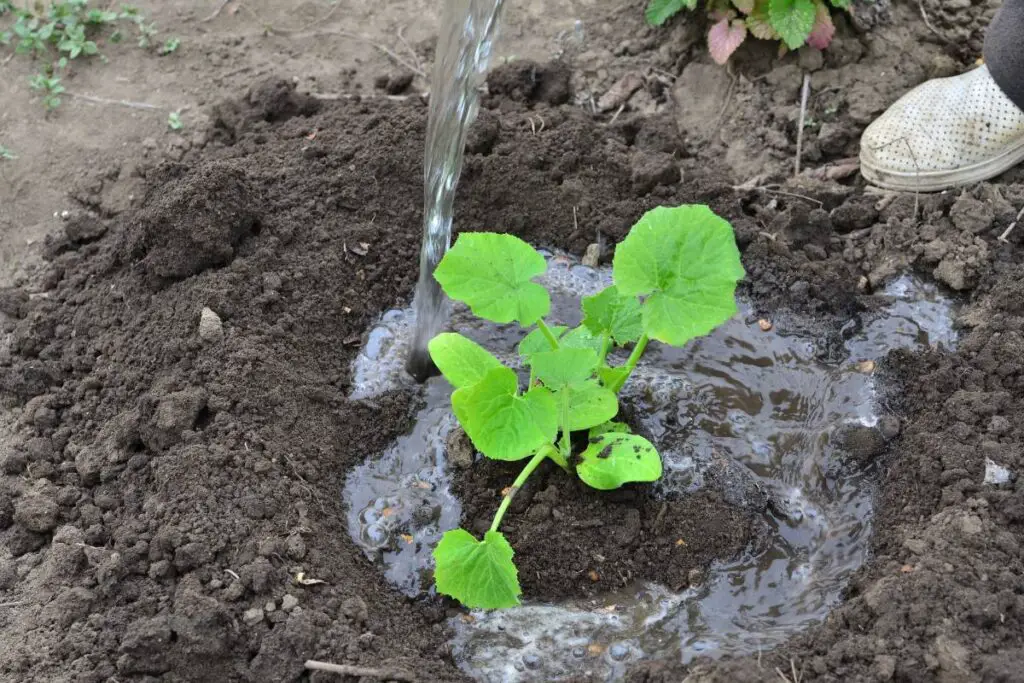
Importance of water for the cucumber plants
- Cucumbers are 96% water. So, without enough water, the plant will produce small and bitter fruits.
- Water plays a significant role in the cucumber plants’ life:
- The plant will need sunlight, water, and carbon dioxide for adequate photosynthesis. Without these three ingredients, the plant can grow but won’t produce any energy to grow fruits.
- When water transfers to other parts of the plant, it dissolves and transports the nutrients to every plant part.
- The mature plant cells maintain their shape through water pressure, which keeps them turgid. The water will help maintain the turgor pressure and keep your cucumber plants in shape.
- Water stimulates the plant’s temperature by transpiration and maintains the thermal pressure. It keeps the plant cool and prevents it from overheating, even during the hot summers.
The optimal amount of water for cucumber plants
Crunchy cucumbers are the typical ingredients for salads.
They are thirsty plants and need much water to produce plumpy and tasty cucumbers.
The cucumbers prefer a deep drink at frequent intervals to remain hydrated and healthy.
Generally, the cucumbers will need 1 inch of water every week.
You can pour this much water in one day or water the plant daily in small amounts. For daily watering, apply only 0.25 inches of water.
Increase to 2 inches of water weekly after your cucumber plants bloom or when the temperature is above 90-95°F. For daily watering, opt for 0.5 inches.
These plants are thirsty and benefit most from a rigid watering routine for optimal growth.
For me, the optimal amount of water for the cucumber plants is 1-2 inches every 1-2 weeks.
I increased slightly to 2.5 inches during the hotter months based on the temperature and weather dryness.
I am always careful about the soil’s moisture level because when I was a beginner, I lost some fruits due to overwatering.
So, I check the moisture level and water the plant whenever the top few inches have dried.
This method works best for me.
I also water them 1-2 times daily during the hottest times of the year. It keeps them hydrated and healthy.
When the temperature is below 90°F, water the cucumber plants once a day.
There is no exact watering frequency for the cucumber plants. Various factors determine the watering frequency.
How to determine the right amount of water for cucumber plants? – Factors affecting the water needs
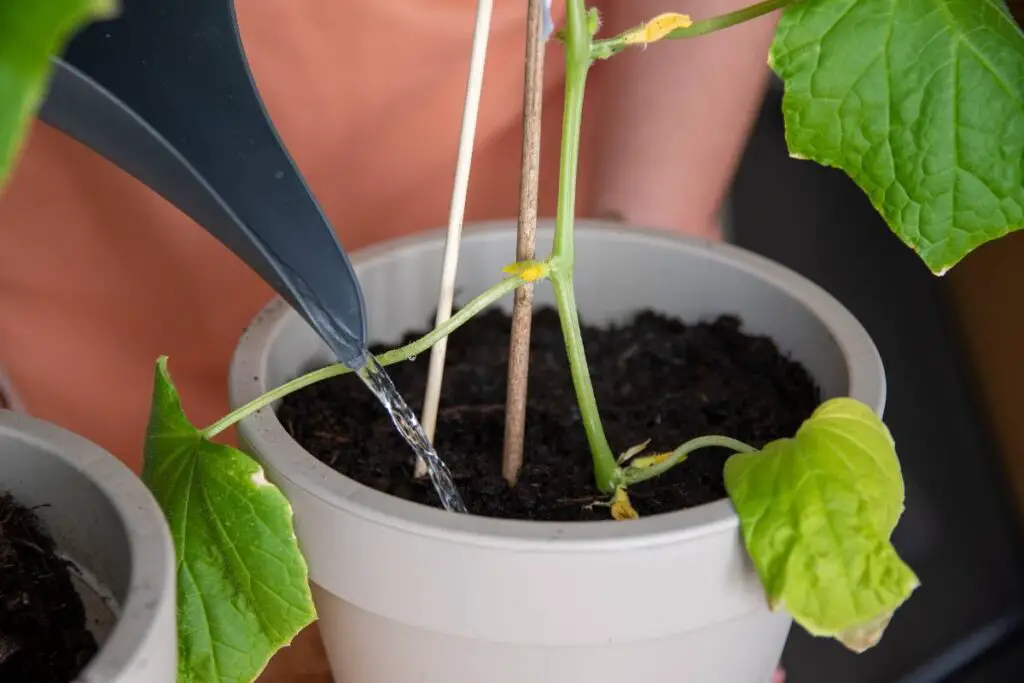
Several factors determine the right amount of water for the cucumber plants.
Usually, there is no exact amount of water because the cucumber plants have numerous watering needs at different times and situations.
After a lot of research and expert advice, I figured out the significant aspects to consider while watering the cucumber plants:
Plant growth stage
At different growth stages, the cucumber plants will need different watering amounts and frequencies:
- A healthy start of cucumber growth assures vigorous growth. So, once you sow the seeds, water them daily for beneficial germination. There is no water amount here. Check the soil moisture daily and water enough to maintain moist soil, not damp.
- When seedlings appear, apply 1 inch of water every week. The water source can be rain or manual irrigation. Consistent hydration will keep the plant healthy and develop a robust root system.
- Once established, apply with 1-2 inches of water when the top few inches have dried.
- Apply 1-2 inches of water every week when the fruits appear. The frequency can change based on the weather. Increase the watering amount and frequency in hot weather and reduce it when the temperature drops.
Season
Summer is the growing season for cucumbers.
So, water them 2-3 days per week for vigorous growth and development.
Spring has rainier weather in some areas. So, you can water your plant with 1 inch of water once weekly.
Add half or 1 inch of extra water during the year’s hottest months.
During the fall months, the plants become well-established.
However, do not increase the watering, as fall is when the cooler weather will set in.
Checking the moisture level before watering and then moistening the soil is the best way to provide enough water to the plants.
Looking for gardening supplies? We have tested 100's of products before recommending them to you guys. Check out our best pick below:
| Image | Gardening Supplies | Best Price? |
|---|---|---|
 Top
Top Top
Top | Raised Garden Bed Kit | Check On Amazon |
 | XLUX Soil Moisture Meter, Plant Water Monitor, Soil Hygrometer Sensor for Gardening, Farming, Indoor and Outdoor Plants, No Batteries Required | No Results |
 Top
Top Top
Top | 82 Pcs Garden Tools Set and Extra Succulent Tools Set | Check On Amazon |
 | Joeys Garden Expandable Garden Hose with 8 Function Hose Nozzle, Lightweight Anti-Kink Flexible Garden Hoses, Extra Strength Fabric with Double Latex Core, (50 FT, Black) | No Results |
 Top
Top Top
Top | Dual Chamber Compost Tumbler | Check On Amazon |
 Top
Top Top
Top | Sunnyglade Plant Stakes | Check On Amazon |
 Top
Top Top
Top | Organic Cold Pressed Neem Seed Oil | Check On Amazon |
 Top
Top Top
Top | Mighty Mint Gallon :-Insect and Pest Control Peppermint Oil | Check On Amazon |
 Top
Top Top
Top | Scotts DiseaseEx Lawn Fungicide | Check On Amazon |
 Top
Top Top
Top | Jacks Classic 20-20-20 All Purpose Fertilizer | Check On Amazon |
 Top
Top Top
Top | 30,000 Seeds Pollinator Attracting Wildflower Mixture | Check On Amazon |
 Top
Top Top
Top | Survival Vegetable Seeds Garden Kit-Over 16,000 Seeds | Check On Amazon |
Temperature or climate
Temperature also determines the exact amount and frequency of water for the cucumber plants.
The ideal temperature for cucumber plants ranges between 65 to 75°F.
If the temperature remains within this range or increases slightly to 80°F, you can apply 1 inch of water every 1-2 weeks.
But if the temperature reaches or crosses 90-95°F, increase the water amount to 2 inches.
Sunlight exposure
Most cucumber plants grow under full sunlight for 6 to 8 hours.
Some gardeners provide 8 to 10 hours of sunlight for the best performances.
The more the plant stays under the sunlight, the more water it will need.
Under direct sunlight, the soil dries faster, especially during the summer.
So, begin with 1 inch of water per week and keep checking the moisture level.
Increase the amount to extra half or 1 inch if needed.
Soil type
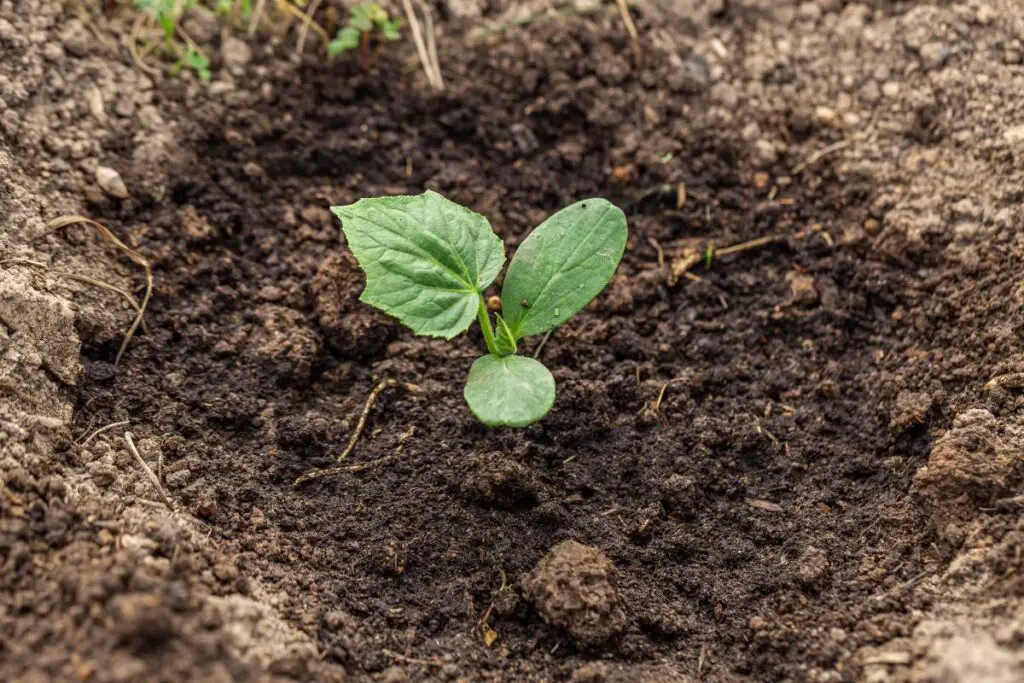
The cucumber plants need sandy, loamy soil that drains well for optimal growth.
You can water the plant with 1 inch of water per week with well-drained soil.
If the soil is poor in drainage, such as clayey soil, you must reduce the water amount and frequency.
Soils like sandy soil that drains faster and dries out quickly, you must increase the amount and frequency.
Keep checking the moisture level and adjust the water amount and frequency accordingly.
Location
Cucumbers grow both indoors and outdoors if provided with a proper care guide.
The watering amount and frequency will vary based on their location. Here’s why.
When you grow cucumbers indoors, they do not receive enough sunlight like the outdoor plants.
So, the soil takes time to dry out after watering. Increase the breaks between the watering and reduce the amount.
In contrast, outdoor plants take less time to dry out because they are exposed to direct sunlight throughout the day.
So, water them frequently.
Keep track of the soil’s moisture level before watering in both situations.
Spacing
As I said, the cucumber plants are super thirsty.
When you plant many without maintaining enough space between them, all the plants compete and fight for the same water you supply.
As a result, you have to water them with more than 1-2 inches of water, along with increased frequency.
Such a condition confuses beginners and leads to overwatering or underwatering.
To avoid this, maintain at least 12 inches of space for horizontal growth in rows. For vertical in trellis, keep 4 inches of distance.
Check the moisture level before watering them.
Landscape or containers
I assumed that cucumbers growing in the landscapes need more water since they are exposed to direct sunlight.
The plants are indeed exposed to the sun but do not always require frequent watering, as we presume.
Since the plants are in the landscape, even when the soil dries out, it can pull up some water from underground. So you do not have to water it too often.
On the contrary, container plants grow in a limited amount of soil with a limited amount of water without any natural water source.
So, they will need more watering than those growing in the landscape.
Effects of Overwatering the cucumber plants
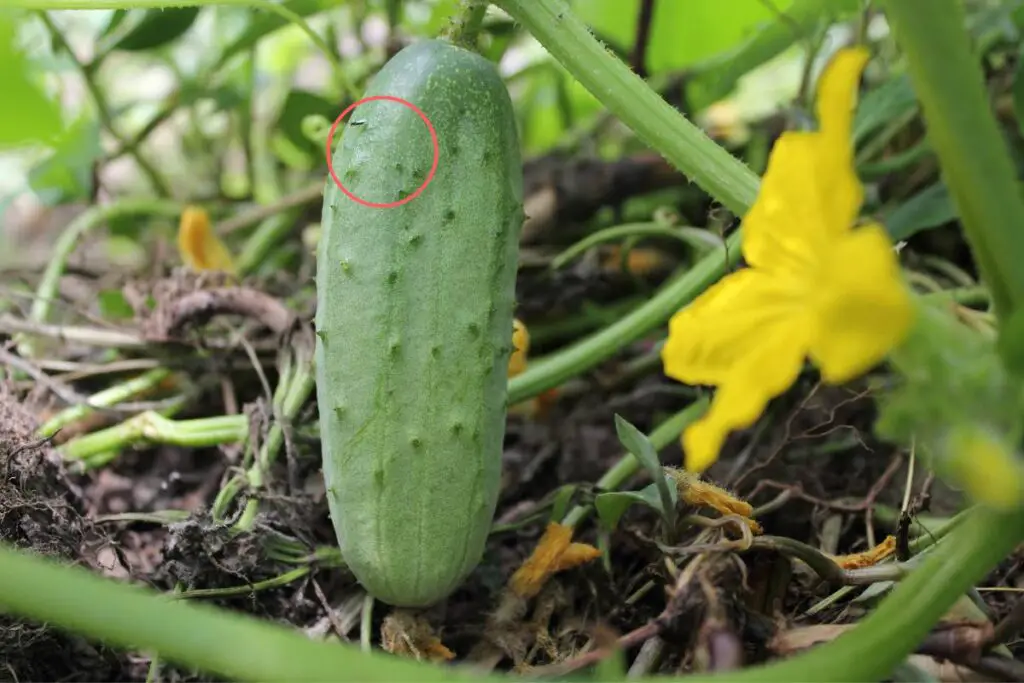
Cucumber plants are undoubtedly thirsty, but too much watering can lead to overwatering.
Frequent watering is the primary cause of overwatering.
When you overwater, the water remains stagnant around the roots and suffocates them.
So, the plant parts cannot receive moisture and end up with yellowing and root rot.
Another reason is poor drainage.
Clayey soil is inferior in drainage and retains moisture around the roots for a long time.
You get similar results while growing cucumbers in pots without drainage holes.
If you water the plant even by following a proper watering routine, your plant suffers from overwatering.
Here are some adverse effects of overwatering that I faced when I overwatered my cucumber plants:
Mold and mildew
Powdery mildew is the result of overhead watering.
It grows over the older leaves when water sits over them, ultimately leading to wilting and yellowing.
Overwatering can develop fungal diseases and mold. Overwatering the plant creates a damp, humid environment, further encouraging mold on the leaves and stems.
Yellow leaves
When you overwater the cucumber plants, the leaves become yellow and soft.
When too much water is in the soil, the roots cannot receive enough oxygen.
So, the roots choke and fail to pass the water and nutrients to the other parts of the plant.
The leaves lose their color due to the lack of water and nutrition.
Over time, the plants will start losing leaves.
Root rot
Root rot is the result of neglecting the yellow leaves and damp soil.
Due to the prolonged overwatering, the roots will stay in the water long, become mushy, and rot.
If not treated, root rot will encourage fungal and bacterial diseases.
The plants growing in the landscape can dry out the soil faster even if you overwater them sometimes because they are exposed to the direct sun.
The potted plants suffer the most from root rot.
How to protect the cucumber plants from excessive water?
It is vital to address the yellowing and damp soil.
If you fix the problem from the beginning, you can prevent root rot.
Here are some steps that I have followed to revive my overwatered cucumber plants:
- If you find yellow leaves, check the moisture level of the soil. If it feels damp, wait for some time and allow the top few inches of the soil to dry out.
- Reduce the water amount and frequency and ensure excess moisture is drained successfully.
- Remove the entire yellow leaves to stop them from using any plant’s energy. As for the partial yellow leaves, they will revive back when the condition becomes ideal for the plant’s growth.
- Next time, always check the moisture level of the soil before watering. Poke your finger in the soil around 1 inch deep to check the moisture.
- If you follow the proper watering routine and still suffer from overwatering, the soil might be the problem. To improve soil drainage, add peat or compost to the soil. Cucumbers can grow in less optimal soil, but the drainage needs to be correct.
- Use pots with drainage holes.
- If you suspect root rot, take out the plant, remove the damaged roots, and replant it in another place or pot with new soil.
- If the weather is humid with plenty of rainfall, water the plant less often and check the moisture level before watering.
Effects of underwatering on cucumber plants
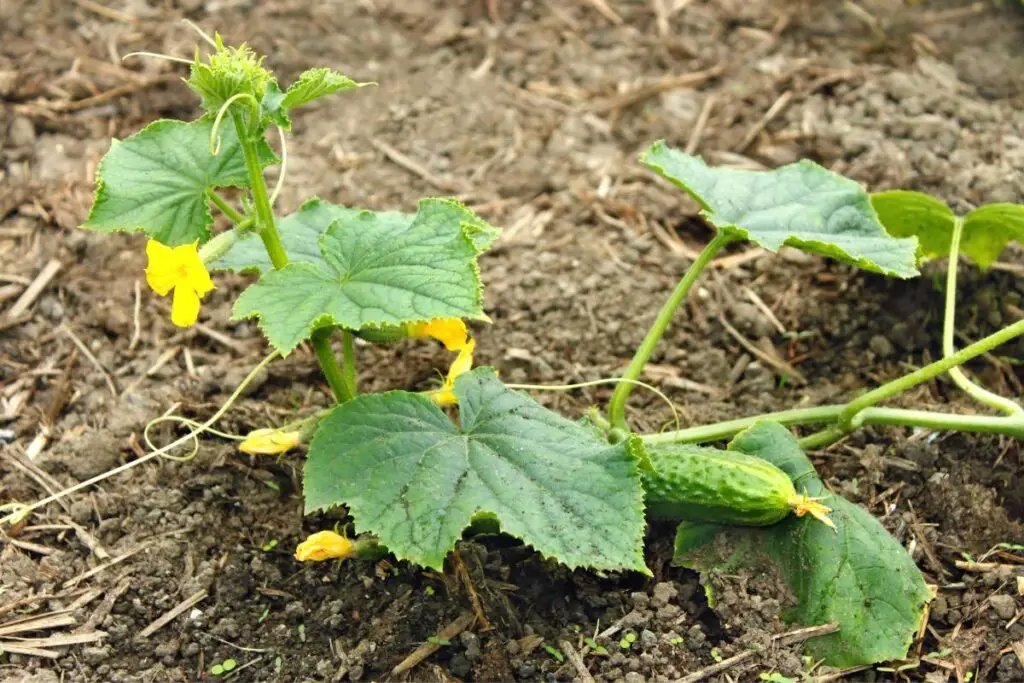
Cucumbers are 96% water. That is why they need consistent moisture levels and hydration.
During the summers, the cucumber plants often suffer from underwatering.
When exposed to too much sunlight, you must increase the watering amount and frequency to keep them hydrated.
Insufficient watering will lead to brittle stems, dry yellow leaves, droopy leaves, and stunted growth.
Soil is also responsible for it, mainly when you use sandy soil.
Sandy soils can drain and dry out faster than usual.
When your cucumber plants suffer from underwatering, the fruits will become bitter.
With insufficient moisture, the fruits produce a bitter cucurbitacin element as self-defense concentrated in the skin and seeds.
How to prevent underwatering and increase the water retention for cucumber plants in dry climates?
Fixing an underwatered plant is more manageable than saving an overwatered plant.
Increase watering, especially for sandy soils and dry climates.
Regularly check the soil’s moisture level and water the plant 1-2 inches weekly.
Please keep it to 1 inch first and check the moisture level. Add an extra half inch if you think the plant needs it.
Usually, you do not need to water them daily. But if the climate is dry, you have to do it.
Increasing water retention is also helpful. For that, try the following methods:
- If your soil is sandy, add compost to the topsoil, around 4 to 6 inches, to improve the retention.
- Add one inch of mulch to the soil. It will retain the water in the soil and stop it from evaporating.
- When you prepare the soil for planting cucumber plants, add organic matter to it to improve water retention.
- Water the plant until the soil is wet to a depth of at least 8 to 10 inches. It will allow the soil to hold moisture for a long time.
- During dry climates, water the plant daily to stop the plant from losing moisture.
Tips for watering the cucumber plants
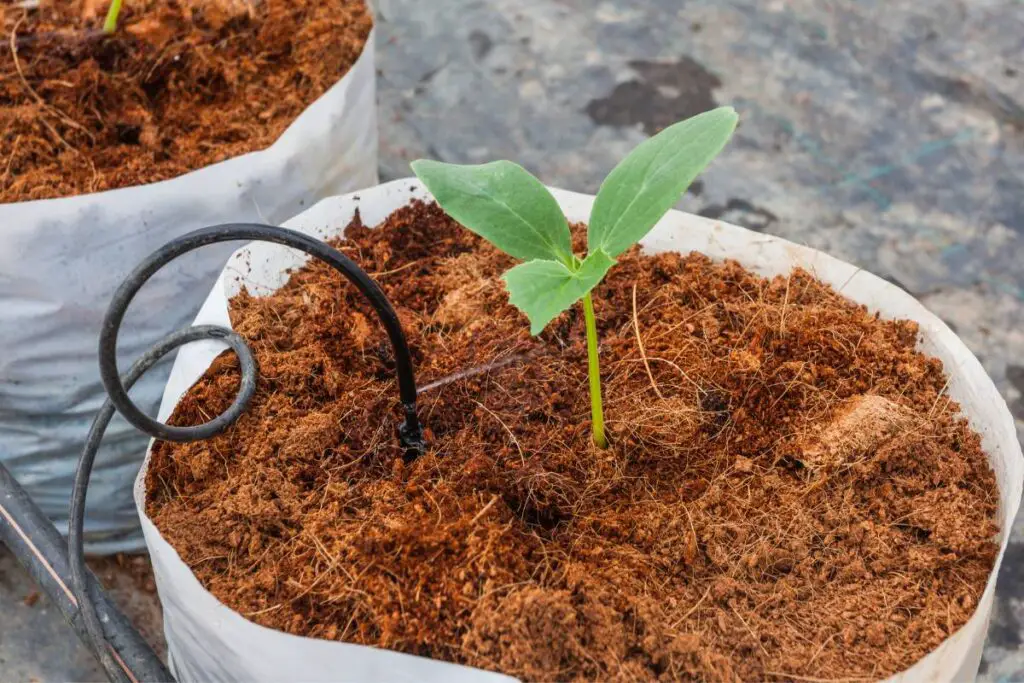
Beginners are prone to making numerous mistakes when starting new plants and veggies.
As a beginner, I have made many mistakes and lost some cucumbers and plants.
After numerous experiments, research, and expert guidance, I have successfully grown multiple vegetables.
Here are some watering tips that I came up with while growing the cucumber plants:
- Just because cucumber plants are thirsty, it does not mean that you can water them vigorously without checking the soil’s moisture level. Overwatering will lead to wilting of the leaves and root rot.
- Sometimes, yellowing leaves are a fertilizer issue and not a watering issue. So, instead of changing the watering routine, check the fertilizer level in the soil.
- When growing cucumbers in a pot, ensure it contains enough drainage holes. Inadequate drainage holes can lead to overwatering.
- If your plant is demanding a lot of water, it may be time to repot the plant.
- Plant the cucumbers in a large pot 14 inches wide and 16 inches deep. The soil in the small pots can dry out quickly and does not give the roots adequate space to spread. In a big pot, the soil can hold enough water for a long time and keep your plant hydrated.
- Install an adjustable soaker hose or drip irrigation system after you sow the cucumber seeds in the ground.
- Water your plants in the early morning or early afternoon. It will allow the water droplets falling over the leaves to dry out quickly.
- Water the plant slowly and deeply to avoid displacing the roots and letting the water reach deeply to the roots.
- Avoid overhead watering and water the plant in the soil.
- The temperature for the root system to absorb water and nutrients should be 68°F. Make sure to use room-temperature water.
- Water the plant according to external factors. For example, sandy textured soil absorbs and needs more water than humus-based soil.
- The soil needs to be well-fertilized so that the plants receive enough nutrition through watering. Soils with good drainage and enough nutrients complement good watering techniques.
Final thoughts
The cucumber plants do best when they receive consistent watering. Generally, cucumber plants are watered with 1 inch of water every week. Add 2 inches of water every 1-2 weeks when the weather is hot. Once the temperatures start to cool down, slowly reduce the watering.
Along with consistent watering, use well-drained soil to avoid overwatering and underwatering. Several factors determine the amount of water and watering frequency, for example, the weather, temperature, soil type, plant growth stages, spacing, and sun exposure timing.
The best method is to check the soil’s moisture level and adjust the watering. Check for signs of overwatering and underwatering and try to revive them. Follow the watering tips I have shared to water the plant without any issues correctly.
Do cucumber plants grow well in pots?
The cucumber plants can grow skillfully in the pot if provided with the correct care tips.
How will I know when my cucumber plants need water?
When your plants need water, they will droop and wilt. Check the moisture level and water them.
Reference: Cucumber Wikipedia

